
35 minute read
NEW KNOWLEDGE
Trillions of atoms in motion could take the form of a new cancer drug or a bendable phone. At the quantum scale, “atoms vibrate, combine, and pile up in very complicated ways,” says UVM chemist Michael Ruggiero.
For his remarkable work in better understanding how these subtle, but very specific, motions of atoms influence the bulk properties of materials people can use, the UVM assistant professor was selected as one of Forbes’ “30-Under-30” leaders in science, their “annual list chronicling the brashest entrepreneurs across the United States and Canada.”
Advertisement
In his Discovery Hall laboratory, Ruggiero and his students hit materials with a powerful laser to tease out the quantum mechanics of molecules. Then they take what they learn in these real-world materials and model their motions on a supercomputer.
“We go from the very basic to the very applied,” Ruggiero says. For example, with insights he gains about the motions of specific molecules, he’s working to help pharmaceutical companies better understand how materials may be interacting to degrade a medication.
“The kind of work we do could lead to drugs with a longer shelf life,” he says. Other examples of where Ruggiero's research program aims to help: improving the ability of semiconductors to work in flexible displays, and better understanding the mechanical properties of gas storage materials for improved hydrogen fuel cells. Young Prof Honored by Forbes
HELPING CATCH ANXIETY AND DEPRESSION EARLY

“Anxiety and depression are surprisingly common among young children—as many as one in five kids suffer from one of them, starting as early as the preschool years. But it can be hard to detect these conditions, known as “internalizing disorders,” because the symptoms are so inward-facing that parents, teachers, and doctors often fail to notice them.
A new tool developed by UVM biomedical engineer Ryan McGinnis and Ellen McGinnis, UVM clinical psychologist, and colleagues in the Department of Psychiatry at the University of Michigan promises to better screen children for internalizing disorders, catching them early enough to be treated.
Their innovative approach was having children in a test group wear motion sensors as they completed a “mood induction task,” a common research method designed to elicit specific behaviors and feelings such as anxiety. Typically, trained researchers would watch a video of the task and score the child’s behavior and speech during the task to diagnose internalizing disorders. In the new study, the wearable motion sensor monitored movement and a machine learning algorithm analyzed that movement to distinguish between children with anxiety or depression and those without.
After processing the movement data, the algorithm identified differences in the way the two groups moved that could be used to separate them, identifying children with internalizing disorders with 81 percent accuracy—better than the standard parent questionnaire. The work was published in the journal PLOS ONE.
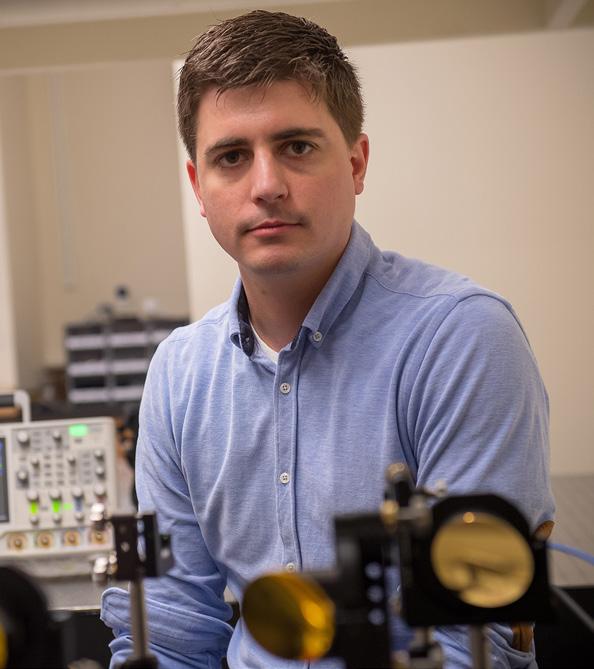
SAFE SKIES UVM’S Spatial Analysis Laboratory, pioneers in using drones to assess emergencies and natural disasters, joins an international team providing expertise as the Federal Aviation Administration examines regulation of unmanned aerial systems, AKA drones. As part of the FAA’s Alliance for System Safety of UAS through Research Excellence, the UVM team will research the use of drones in disaster situations, providing the agency with data for their safe operations in times of disaster.

PRI VACY MATTERS
Individual choice has long been considered a bedrock principle of online privacy. If you don't want to be on Facebook, you can leave or not sign up in the first place. Then your behavior will be your own private business, right?
Not so much. A study by a team of scientists at UVM and the University of Adelaide shows that privacy on social media is akin to second-hand smoke. It's controlled by the people around you.
Led by UVM mathematician James Bagrow, the team gathered more than thirty million public posts on Twitter from 13,905 users. With this data, they showed that information within the Twitter messages from eight or nine of a person's contacts make it possible to predict that person's later tweets as accurately as if they were looking directly at that person's own Twitter feed.
The study, published in Nature Human Behavior, also shows that if a person leaves a social media platform—or never joined—the online posts and words of their friends still provide about 95 percent of the "potential predictive accuracy," the scientists write, of a person's future activities—even without any of that person's data.
The research raises profound questions about the fundamental nature of privacy—and how, in a highly networked society, a person's choices and identity are embedded in that network. The new study shows that, at least in theory, a company, government, or other actor can accurately profile a person—think political party, favorite products, religious commitments—from their friends, even if they've never been on social media or deleted their account.
Beyond the Slumdog Spotlight
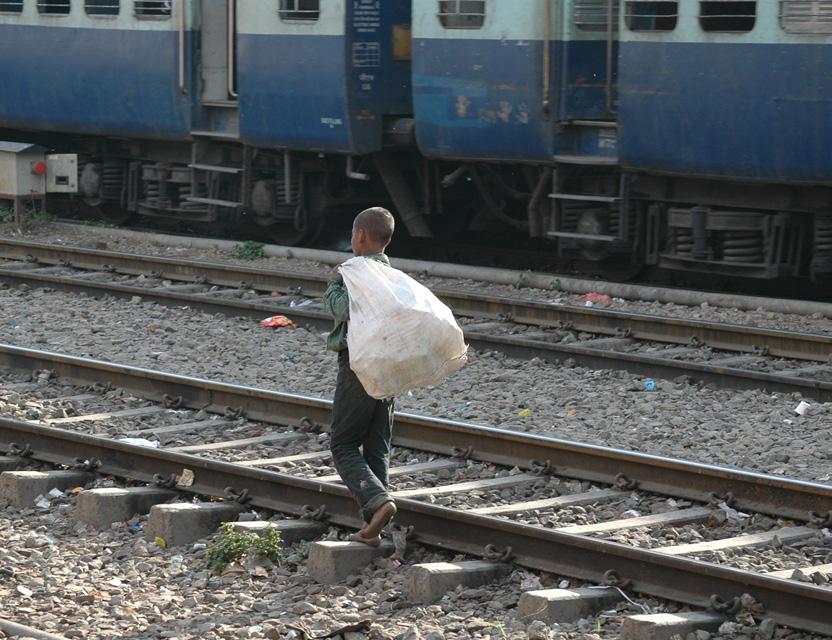

ACROSS YEARS OF TRAVEL and research in India, Jonah Steinberg has encountered scores of children in trying circumstances or outright peril. And for more than a decade, the UVM associate professor of anthropology has built relationships with these children and compiled their stories for an ethnographic exploration of the cultural, social, and historical forces that draw them away from their rural Indian homes and into high-risk cities. His latest book, A Garland of Bones: Child Runaways in India (Yale Press), serves as a reflection on the issues at play and illuminates this highly marginalized population.
The majority of street kids featured in Steinberg’s book are not abandoned, but actively choose to leave troubling situations at home. They travel hundreds of miles, usually via train, to populated cities where they plan to acquire work. Many die, but nearly all face some degree of daily threat—getting struck by trains and cars, drug addiction, disease and illness, human trafficking and sexual exploitation, to name a few. Some kids return home, but most do not. So why would they choose to live this life?
Over the course of his work, which was supported by a grant from the National Science Foundation, Steinberg says many of the children he came to know cited familial abuse and poverty in their villages as reasons for running away. Yet, Steinberg notes, those children had the autonomy and resources to physically leave. “On one hand, it appears to be a choice to run away, but on the other, it’s also a lack of choice. There are large historical forces at work that make rural livelihoods more difficult and stressful,” he says.
As an anthropologist, Steinberg strives to connect swaths of history to contemporary life. In A Garland of Bones, he makes the case that runaway children are pushed by centuries of history to leave their rural lands. For example, Indian indigo farming during British colonialism in the 1800s indebted families, devastated once-fertile lands, and resulted in massive agrarian exploitation at the time. Two hundred years later, villagers on those same lands still suffer from depleted soils and inescapable poverty, which causes high stress and preventable illness among families.
“That’s not something that can absolutely be proven,” Steinberg says, “but the book is more of a meditation on that process. It looks to disrupt what we think of as normal. Poverty is directly related to vast systems of history, of which we’re a part.”
FOOD INSECURITY ON THE FARM
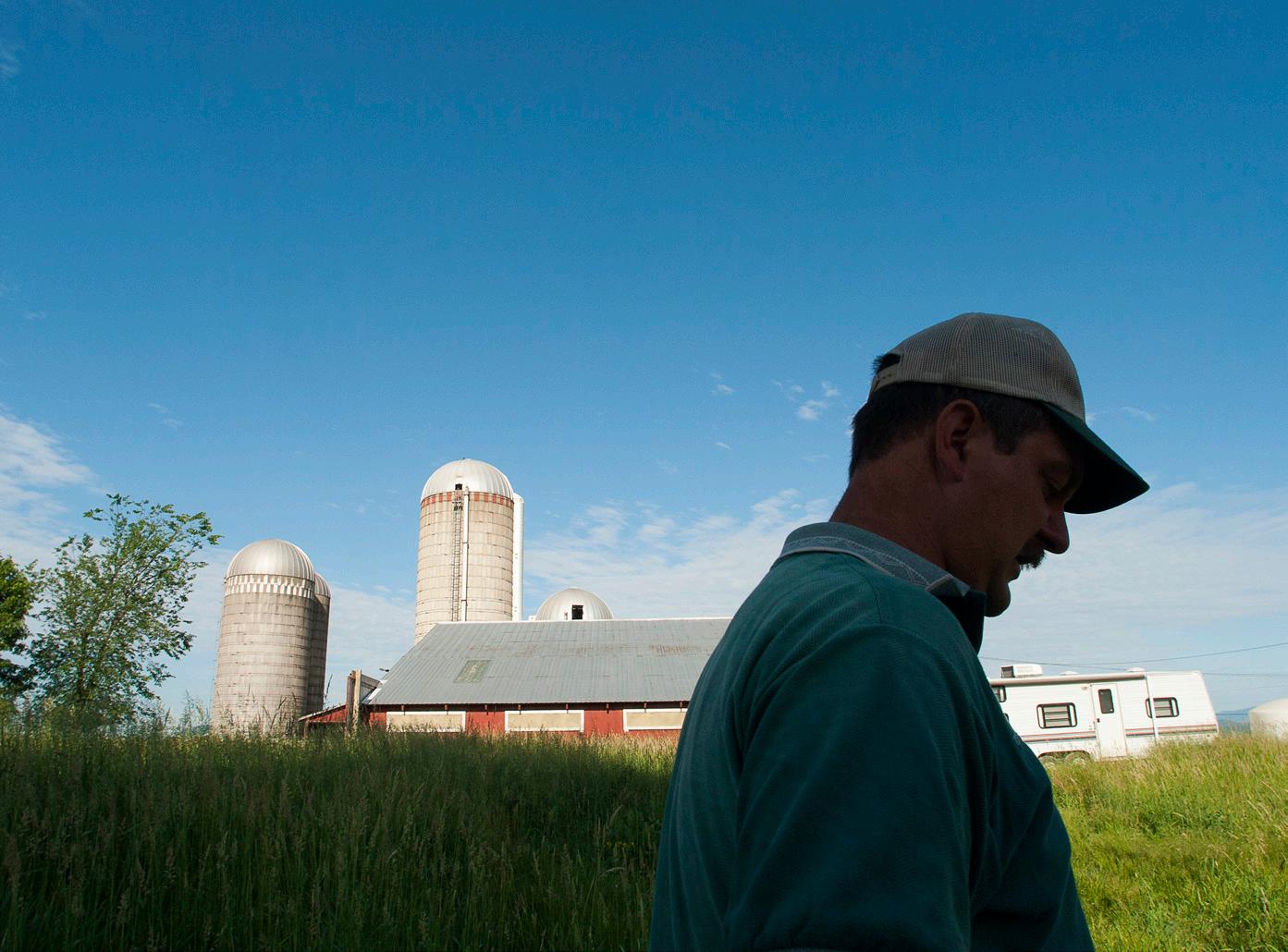

Since the late 1990s, undocumented Mexican and Central American farm workers on Vermont’s dairy farms have played an essential role in bringing milk and other products to market. But while the laborers help to feed others, many face significant barriers in accessing food themselves, according to Theresa Mares, professor of anthropology.
Her exploration of food insecurity among the state’s undocumented farm workers is documented in Life on the Other Border, Farmworkers and Food Justice in Vermont (University of California Press). In the book, the first to measure food insecurity in this population, Mares writes that 18 percent of Vermont's undocumented migrant farm workers are food insecure, defined as lacking reliable access to a sufficient quantity of affordable, nutritious food. That compares to between 13 and 14 percent for Vermonters as a whole. While that number is troubling, it’s likely much too low, given the unique circumstances of Vermont’s migrant farm workers, Mares says.
Though economic difficulties are certainly part of the equation, many of Vermont’s migrant laborers face a stiffer challenge with access, fearing that leaving the farms where they work to buy food will expose them to arrest by Border Patrol agents.
“Food insecurity is about getting enough food and the right kind of food, but it’s also about the emotional and mental health impacts of being isolated and constantly under stress and anxiety—being worried about food,” Mares says.
While the book focuses on Vermont, its insights are applicable to a wide swath of the nation’s northern border. “Wisconsin, New York, and Washington have similar issues,” Mares says. “Wherever you have large dairy operations, you have undocumented labor. If the farms are near the Canadian border, they’re experiencing many of the problems Vermont is seeing, including, and especially, around the issue of food insecurity.”
I recognize the need to occasionally escape from the ugliness of the real world into fictional ones with happy endings. But in a media environment dominated by entertainment, it’s also important to be periodically shocked into remembering that things don’t always work out so nicely.” “ QUOTE UNQUOTE
Anthony Gierzynski in an essay published by The Conversation. The professor of political science discussed “Game of Thrones” and his studies of the impact of media consumption upon political perspective.
CANARIES OF THE REEF


UVM SCIENTIST Nate Sanders was part of an international research team that found that when water temperatures heat up for corals, fish “tempers” cool down. The study provides the first clear evidence of coral bleaching serving as a trigger for rapid change in the behavior of reef fish.
Publishing in Nature Climate Change, the researchers show how the iconic butterflyfish, considered to be sensitive indicators of reef health, can offer an early warning sign that reef fish populations are in trouble.
The team of scientists spent more than six hundred hours underwater observing butterflyfish over a two-year period encompassing the unprecedented mass coral bleaching event of 2016. Led by marine ecologist Sally Keith of Lancaster University, the team examined seventeen reefs across the central Indo-Pacific in Japan, the Philippines, Indonesia, and Christmas Island in the Indian Ocean.
“This matters because butterflyfishes are often seen as the ‘canaries of the reef,’” says Nate Sanders, director of UVM’s Environmental Program and professor in the Rubenstein School of Environment and Natural Resources. “Due to their strong reliance on coral, they are often the first to suffer after a disturbance event.”
Such changes in behavior may well be the driver behind more obvious changes such as declining numbers of fish individuals and species.
“It’s not just that we’ve documented a climate change effect on these reefs,” adds Sanders, a fellow in UVM’s Gund Institute for Environment. “It’s important that we’re beginning to understand why these changes happen and are building the knowledge to try to predict when, and where, these kinds of changes may happen in other ecosystems in the future.”
For weight loss, research shows, the single best predictor of success is recording calorie and fat intake throughout the day. “Write it when you bite it,” so to speak. But dietary selfmonitoring is commonly viewed as so unpleasant and time-consuming, many can’t muster the will power to do it.
However, new research published in Obesity suggests that the reality of dietary self-monitoring may be far less disagreeable than the perception. The study, conducted by researchers at UVM and the University of South Carolina, is the first to quantify the amount of time that dietary selfmonitoring actually takes for those who successfully lose weight. Jean Harvey, professor of nutrition and food sciences and interim dean of UVM’s College of Agriculture and Life Sciences, was lead author of the study.
The research established that after six months of monitoring their dietary intake, the most successful participants in an online behavioral weight-loss program spent an average of just 14.6 minutes per day on the activity. Program participants recorded the calories and fat for all foods and beverages they consumed, as well as portion sizes and preparation methods.
What was most predictive of weight-loss success was not the time spent monitoring—those who took more time and included more detail did not have better outcomes—but the frequency of log-ins, confirming the conclusions of earlier studies.
The study's most important contribution may be in helping prospective weight-losers set behavioral targets, Harvey suggests. “We know people do better when they have the right expectations. We've been able to tell them that they should exercise 200 minutes per week. But when we asked them to write down all their foods, we could never say how long it would take. Now we can.” HELPING CLEAR A BARRIER TO WEIGHT LOSS


The National Climate Assessment is the United States government’s premier resource for articulating the risks and impacts posed to the nation by climate change. The interagency effort brings together experts from not only the thirteen federal agencies of the U.S. Global Change Research Program, but the broader federal government, and hundreds of experts in the academic, nonprofit, and private sectors.
UVM Professor of Geography Lesley-Ann Dupigny-Giroux, who also serves as the Vermont State Climatologist, was the lead author of the Northeast chapter of Volume II of the Fourth National Climate Assessment, issued in late 2018.
Without substantial and sustained global efforts to reduce greenhouse gas emissions and regional initiatives to prepare for anticipated changes, the report anticipates climate change is expected to have implications for human health and wellbeing, cause growing losses to American infrastructure and property, and impede the rate of economic growth over this century.
Dupigny-Giroux is an expert on floods, droughts, and geospatial technologies and the ways in which climate affects Vermont’s landscape and people. Speaking to regional impacts, in particular, she said: “One of the key takeaways are the observed and anticipated risks posed to our ‘forests, wildlife, snowpack, and streamflow’ in our rural environments as our climate changes. Another is that the ongoing impacts to human health are also of great concern to our region. Climate change is also affecting the interconnectedness of the urban centers of the northeast. Finally, northeastern states, including Vermont, continue to be very proactive in planning for and implementing actions to reduce risks posed by climate change.” Eye on Climate Change

Each year brings new research showing that oil and natural gas wells leak significant amounts of the potent greenhouse gas methane. A UVM study published in the journal Environmental Geosciences is the first to offer a profile of which wells are the most likely culprits.
The research, conducted by Civil and Environmental Engineering Professor George Pinder and James Montague, his former doctoral student, is based on a study of 38,391 natural gas and oil wells in Alberta, Canada. Companies in that province are required to test wells at the time they begin operating to determine if they have failed and are leaking natural gas, which contains methane, and to keep careful records of each well’s construction characteristics.
The study used a machine learning algorithm to correlate wells that leaked and those that didn’t with a set of sixteen characteristics.
“The big picture is that we can now have a tool that could help us much more efficiently identify leaking wells,” Pinder says. “Given that methane is such a significant contributor to global warming, this is powerful information that should be put to use.” BETTER TRACKING GREENHOUSE GAS
Ensuring Poverty: Welfare Reform in Feminist Perspective Gwendolyn Mink and Felicia Kornbluh, History University of Pennsylvania Press
Ecology and Recovery of Eastern Old-Growth Forests Edited by Andrew M. Barton and William S. Keeton, Forestry Island Press
Lingua Franca: Chamber Music of David Feurzeig CD featuring multiple musicians performing the compositions of David Feurzeig, Music and Dance AMR-Naxos
The Baseball Glove: History, Material, Meaning, and Value David Jenemann, English Routledge
Nazism, the Holocaust, and the Middle East: Arab and Turkish Responses Edited by Francis R. Nicosia and Boğaç A. Ergene, History and Holocaust Studies Berghahn Books
How Color Works: Color Theory in the 21st Century Pamela Fraser, Art and Art History Oxford University Press
Golden Fruit: A Cultural History of Oranges in Italy Cristina Mazzoni, Romance Languages and Linguistics University of Toronto Press
Still Lives Novel by Maria Hummel, English Counterpoint
Bacterial Pathogens and Their Virulence Factors Douglas I. Johnson, Microbiology and Molecular Genetics Springer
A Dictionary of Cultural Anthropology Luis Vivanco, Anthropology Oxford University Press
Halal Food: A History Febe Armanios and Boğaç Ergene, History Oxford University Press
The Birds and the Bees...
and the Coffee
ON SABBATICAL in Costa Rica, Taylor Ricketts drank a lot of coffee. “Everything is done over coffee there,” he says. Including launching a new research project with two scientists at a tropical agriculture center in the mountains—to study coffee. As an ecologist and director of UVM’s fast-growing Gund Institute for Environment, Ricketts wants to better understand how nature benefits people—like the pollination work that bees do in coffee farms, and the pest-control work that birds do, eating beetles that would otherwise eat the seeds of the coffee fruit. “We found more than thirty different species of native Costa Rican bees visiting coffee flowers,” Ricketts says—such as the orchid bee, Euglossa viriabilis, pictured here—“so it’s not just a couple of bees that do this work. It’s a really a diverse community.” Like many plants, coffee can produce a crop without animals moving pollen around. But bees increase yields by about twenty percent and migratory birds can reduce beetle infestations by half. Ricketts and his two collaborators—

one from Mexico and one from
Nicaragua, as well as a new UVM doctoral student, Natalia Aristizabal, from Colombia—hope to understand the interplay within this system more clearly. “We want to see how dependent coffee is on native species that live in and around it,” Ricketts says. “And we want to know how much each is worth—bees and birds—and, crucially, how much they’re worth together.” Will it pay for Costa Rican farmers to increase the number and diversity of shade trees on their farms? How about using organic methods? The team is studying thirty farms, where they have covered some plants with bee-excluding nets, others with bird-baffling mesh sheds, some with both. Early in the new year, the scientists will be harvesting the coffee from their experiments—just steps ahead of the commercial harvesters—to start answering some questions. “Is there synergy between what bees need and what birds need? To be profitable, what kind of land management should farmers choose?” Ricketts says. “That’s what we’re trying to figure out.”
THE DOWNSIDE OF OPTIMISM
Most people think of optimism as a good thing—a positive outlook in challenging circumstances. But in a healthcare setting, it’s a psychological state that can be “contagious” in a bad way.
A June 2019 study in the journal Psycho-Oncology details how a seriously ill patient’s optimism can impact a clinician’s survival prognosis in palliative care conversations. Senior author Robert Gramling, associate professor of family medicine and the Miller chair in palliative medicine at the Larner College of Medicine, feels that clinicians have a duty to estimate prognosis as accurately as possible. If survival is overestimated, Gramling and his coauthors from Purdue University, the University of Rochester, and University of California San Francisco write, “these errors in judgment can prevent patients from making timely decisions about their end-of-life care.”
For their study, the researchers enrolled 189 hospital patients with advanced cancer undergoing palliative care consultations at two geographically distant sites. The study’s findings showed a generally high level of both dispositional and prognostic optimism just before palliative care consultation, as well as a correlation between higher levels of patient optimism and clinicians’ greater likelihood of overestimating survival, even after adjusting for clinical markers of survival time.
“Our study suggests that patient-level optimism might exert an unforeseen influence over palliative care clinicians’ prognostic judgments,” wrote Gramling and his coauthors. “If so, then raising clinician awareness about these effects and including debiasing steps in prognostication skills training may lead to more accurate estimates.”
Data analyses for the study took place at UVM’s Vermont Conversation Lab, where Gramling and his colleagues both conduct research and develop training sessions through their TalkVermont program to help clinicians gain conversational proficiency. This study was funded by a Research Scholar Grant from the American Cancer Society.
TREES IN CITIES: WHAT’S NOT TO LIKE?


Trees are a hallmark of vibrant neighborhoods. So why did nearly one-quarter of eligible residents in Detroit, Michigan, turn down free street trees? That’s the mystery UVM researcher Christine Carmichael solves in one of the first studies to explore opposition to city tree planting programs.
As cities from New York to Los Angeles embark on major tree planting initiatives, the research helps to explain why more than 1,800 of 7,425 eligible Detroit residents—roughly 25 percent—submitted “no-tree requests” between 2011 and 2014 alone.
Carmichael, a postdoctoral researcher at UVM’s Gund Institute for Environment and Rubenstein School of Environment and Natural Resources, found that the opposition in Detroit resulted primarily from negative past experiences with street trees, particularly in low-income neighborhoods grappling with blight from vacant properties.
For many long-term residents, wariness of the new trees was driven by past experiences of caring for vacant properties in their neighborhood. Carmichael also found that skepticism of the program was tied to wider distrust of the city government and outside groups in parts of Detroit. As a result, residents wanted greater decision-making power in selecting which trees to plant in particular locations, adds Carmichael who completed the three-year study for her PhD with co-author Maureen McDonough of Michigan State University.
Carmichael’s study, published in Society and Natural Resources journal, is gaining attention from city planners across North America hoping to learn Detroit’s lessons. Local governments and non-profits in Austin, Denver, Indianapolis, Sacramento, Toronto, and Vermont have reached out for help implementing her research.
“We need to broaden the measurable outcomes that we can gauge success by,” says Carmichael. “Healthy urban forests cannot be measured just by the number of trees planted. We also have to capture who is involved, and how that involvement affects the well-being of people and trees in the long-term.”
WORLDWIDE PRESS
More than two hundred stories featuring the University of Vermont, most of them focused on UVM research and scholarship, appeared in international, national, and regional outlets during the past academic year. A “Share of Voice” analysis conducted by Cision indicates UVM’s coverage routinely exceeds that of institutions such as Northeastern University, University of Massachusetts, Syracuse University, and University of New Hampshire. Outlets that have shared UVM’s story in the past year include:
BBC Science Reuters ABC News Fast Company CNN United Press International CBS This Morning New York Times Wired Marketplace Public Radio International Boston Globe Today.com NSF’s Science 360 Washington Post Chronicle of Higher Education Salon Newsweek U.S. News
A Difficult American Story

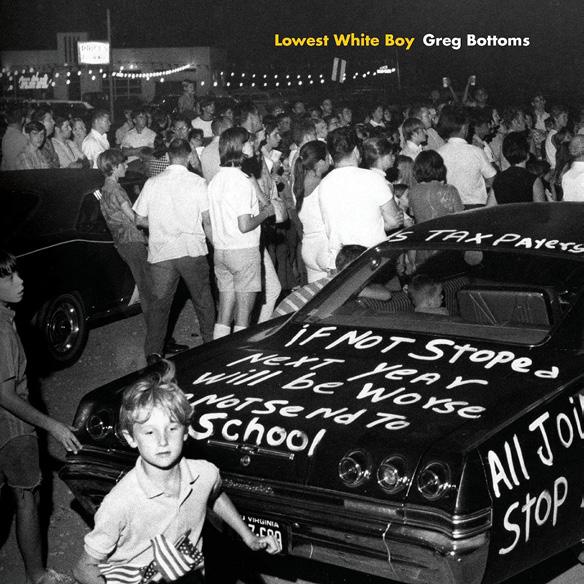
“‘IF YOU CAN CONVINCE the lowest white man he’s better than the best colored man, he won’t notice you’re picking his pocket. Hell, give him somebody to look down on and he’ll empty his pockets for you,’” quotes English Professor Greg Bottoms. Those words came from President Lyndon B. Johnson at a time when opposition to civil rights was escalating and racial anxieties were the strings pulled by political puppet masters to get voters to dance. Growing up in Tidewater, Virginia, under the influence of a white working-class family, Bottoms admits he was that “lowest white man,” or better yet, boy.
In his latest book, Lowest White Boy (West Virginia University Press), Bottoms confronts our vulnerability to white supremacy and racism—himself included—and exposes the racial forces that have perpetuated American racism for centuries. Part memoir, part history book, part academic textbook, and part visual essay, Bottoms declares it a “hybrid” book that offers anecdotes from his own experience with racism, old newspaper photographs, and a deep dive into the history, policies, and psyche of America and the South.
“Racism and white supremacy have been foundational and carefully enacted through policy and law and are systematically enmeshed and sometimes hidden, rather than just some personal, correctable attitudes,” he says. “I’d like to think I’m offering a way to understand some part of the background to our really deranged current social, cultural, and political foreground.”
“If you can convince the lowest white man he’s better than the best colored man, he won’t notice you’re picking his pocket.” —President Lyndon B. Johnson
THREE FACULTY NAMED TO LIST OF WORLD’S MOST INFLUENTIAL RESEARCHERS
Three UVM faculty were named to a list of the world’s most impactful researchers for 2019, based on the number of times their published studies have been cited by other researchers over the past decade. Researchers on the list are in the top one percent of all scholars whose work has been cited by others. The prestigious Highly Cited Researchers list is compiled and published annually by Clarivate Analytics.

Vermont faculty named to the list are: William Copeland, professor of psychiatry in the Larner College of Medicine and director of research, Vermont Center for Children, Youth and Families Mary Cushman, professor of medicine and of pathology and laboratory medicine in UVM’s Larner College of Medicine Taylor Ricketts, director of UVM’s Gund Institute for Environment and Gund Professor at the Rubenstein School of Environment and Natural Resources
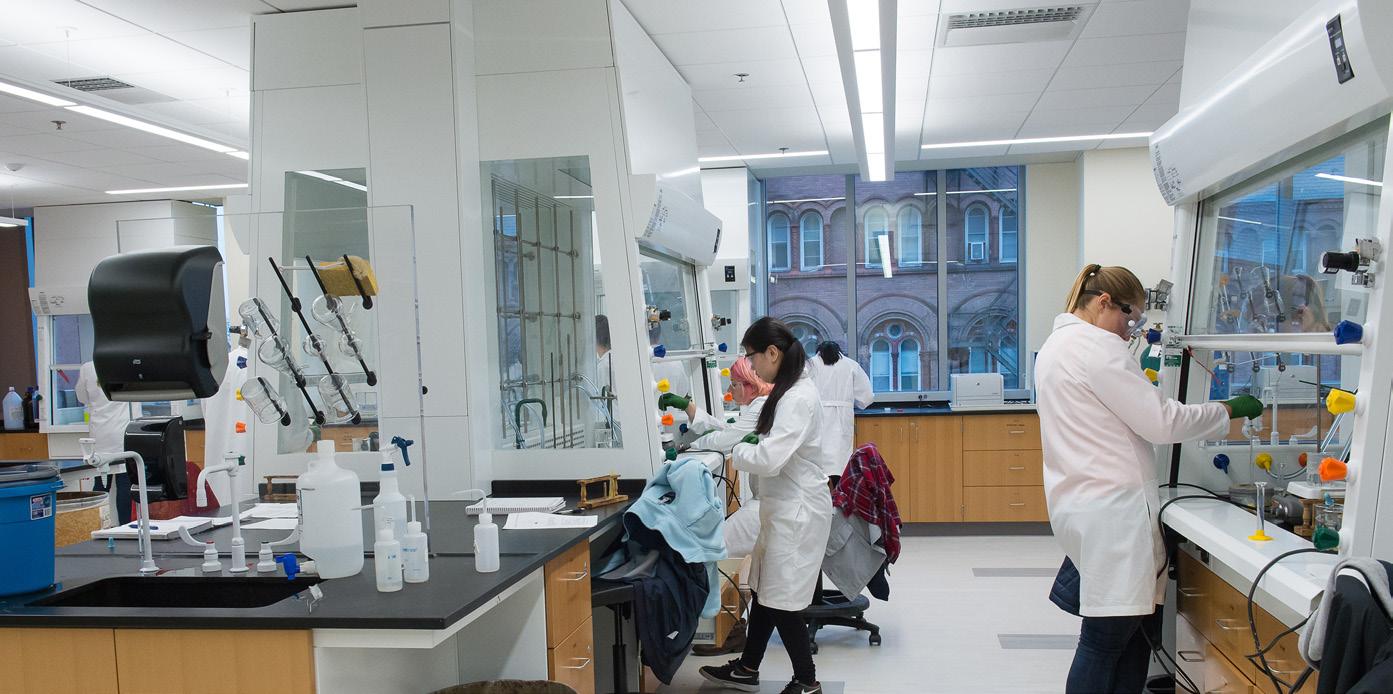
The recent completion of Discovery and Innovation halls—part of the university’s $104 million investment in new science and technology facilities—has greatly improved research and teaching laboratories, and better enabled collaboration. Discovery’s tall windows and glass walls fill fourteen new teaching labs and twenty-two faculty research labs with light. The open floor plans allow ENVIRONMENT OF DISCOVERY
for research teams to work across disciplines; scientists from chemistry, physics, engineering, mathematics, and computer science merge their efforts here.
With some 1,200 undergraduates taking introductory chemistry each year, the new spaces have allowed faculty to, “totally revamp how we teach courses, closely linking lectures and lab time,” says Chris Landry, chemistry chair. “It’s the building that’s driving all sorts of curricular change outward.”
BUSINESS IS BETTER TOGETHER
Entering midway through a conversation with Chun Zhang about her research, one might easily mistake the Grossman School of Business professor for a relationship coach. And to some extent, Zhang says, her research examining business-tobusiness (B2B) relationships may be applied to personal relationships.
“I’m interested in understanding relationship management after disruptions, and I’m trying to find a practical solution for companies and people who want to continue a valuable relationship, but can’t solely count on the other party. High quality relationships are fundamental to our wellbeing,” Zhang says.
Her latest B2B research, published in Industrial Marketing Management, explores ways that companies can recover trust in a business relationship after they’ve been offended by an opportunistic partner company. Zhang navigates three routes an offended company might take: tolerance, aggression, or collaboration.
Ultimately, Zhang finds that it’s better to “be collaborative rather than punitive if you want to restore trust. Sticking together may be a less costly solution than switching to something completely new.” Zhang says the best route to repair trust with a business partner after an offensive, opportunistic incident may be socializing and engaging with employees of the offending company, specifically outside of standard business settings, like teeing up on the golf course, for example. “You need to work on their motive or their values to make them feel and see that pursuing common goals is more advantageous than thinking and acting selfservingly.”
Prescribing Exercise for Mental Health

A LECTURER IN rehabilitation and movement science, and inpatient psychotherapist at UVM Medical Center, David Tomasi notes that the number of psychiatric patients seeking acute, inpatient treatment has steadily increased since the ’90s at the start of the opioid crisis. A majority of the patients he treats at UVMMC are young adults suffering from dual-diagnoses of a mood disorder and addiction, typically to opioids.
“There aren’t enough beds. We have struggles with opioid addiction and suicidality, and it’s a crisis we’ve never seen before on a national level in the United States. Especially in the northeast, especially in New England, but even more so in Vermont. We are really struggling,” he says.
At UVMMC, where Tomasi and his colleagues Sheri Gates and Emily Reyns treat patients suffering from a range of mood and mental health disorders, a new idea surfaced: What if practitioners prescribed patients exercise as part of their treatment plans?
To explore the potential of this mind-body connection, Tomasi, Gates, and Reyns were awarded an inaugural University of Vermont

Medical Center Fund grant that enabled them to build a gym, exclusive to patients in UVMMC’s inpatient psychiatry unit. For roughly one hundred patients in the unit, treatment plans included new sixty-minute nutrition education programs and structured exercise classes, all monitored by psychotherapists.
A remarkable 95 percent of patients reported that their moods improved after doing the structured exercises. Overall, patients reported reduced levels of mood disorder symptoms like anger, anxiety, and depression and higher levels of self-esteem and improved moods.
Based on the study’s positive results, Tomasi believes incorporating American College of Sports Medicine-approved exercises into inpatient treatment would not only improve patients’ symptoms faster than classic pharmacological intervention alone could— thus increasing facilities’ bed and patient turnover rates—but would also offer patients an alternative, holistic, and cost-effective approach to maintaining their mental health after discharge.
ABOVE: David Tomasi offers a primer on brain function. See the video: go.uvm.edu/tomasi
DEEP GREEN


With a massive upgrade in summer 2019, UVM now has one of the fastest supercomputers in New England and one of the 100 fastest academic supercomputers in the country. The new computing cluster at the Vermont Advanced Computing Core, dubbed DeepGreen, was expanded on the strength of a $1 million grant from the National Science Foundation.
The upgrade positions the university well, says Adrian Del Maestro, associate professor of physics, director of the VACC and principal investigator on the NSF grant. According to Del Maestro, the increase in processing speed, combined with hyperfast network connections within the cluster, will enable faculty to take on new types of research projects they did not have the computational power to explore in the past.
Professor and Chair of Microbiology and Molecular Genetics Beth Kirkpatrick sees the new UVM research center for which she is principal investigator as a toolbox for improving lives around the globe. “Effective responses to infectious disease burdens and threats must capitalize on new technologies and analytical tools,” she says.
The new Center of Biomedical Research Excellence (COBRE) called the “Translational Global Infectious Disease Research Center” (TGIR) was announced in October 2018 with $12.3 million in funding from the National Institutes of Health. The research initiative will leverage UVM expertise in the Larner College of Medicine, the College of Engineering and Mathematical Sciences, A Toolbox for Better Health
and the College of Agriculture and Life Sciences to develop strategies for decreasing the burden of infectious diseases, particularly in low-income countries.
The TGIR-COBRE aims to bridge the gap between the biologic and quantitative data fields of biomedical research by developing institutional strengths in global infectious disease research and supporting the research careers of outstanding junior faculty in this field.
The TGIR center incorporates existing research strengths in human infectious diseases and the platforms of the UVM Vaccine Testing Center. The center also makes use of UVM’s substantial expertise in complex systems and mathematical/computational modeling.
Co-principal investigators on the TGIR-COBRE are Jason Bates, professor of medicine, and Christopher Huston, professor of medicine.
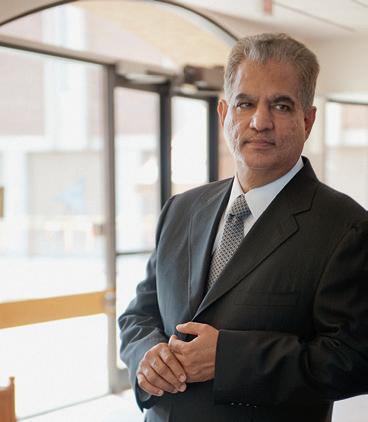
GROSSMAN DEAN HONORED FOR SUSTAINABLE ENTERPRISE SCHOLARSHIP
Sanjay Sharma, dean of the Grossman School of Business, was a 2018 Fetner Sustainable Enterprise Fellow. The prestigious research fellowship is made annually to a leading international scholar in sustainable enterprise.
A Fulbright Scholar with extensive experience in the private sector, Sharma has expertise in corporate environmental strategy, corporate sustainability, competitive strategy, stakeholder engagement, and organizational innovation. He has written and co-edited nine books on corporate sustainability and has won several prestigious awards for his research, including the Academy of Management ONE Division’s Distinguished Scholar Lifetime Achievement Award in 2016.
Fetner Fellows participate in a three-day residency, delivering a series of research lectures to faculty and graduate students at Syracuse University’s Whitman School of Management and L.C. Smith College of Engineering and Computer Sciences, and the SUNY College of Environmental Science and Forestry.
ENDING AN ACADEMIC EMBARGO

CUBA HAS BECOME a key nation in global research efforts by UVM’s Gund Institute for Environment and the Rubenstein School of Environment and Natural Resources. But while teaching UVM courses on-site in Cuba and collaborating with Cuban scientists, UVM conservation biologist Joe Roman learned of a significant impediment to advancing knowledge of the island and surrounding sea.
Working with Patricia GonzálezDíaz, director of the University of Havana’s Center for Marine Research, Roman heard of the challenge she faced in publishing in the Florida-based Bulletin of Marine Science, a leading journal in the field. In short, her PhD dissertation was rejected for publication without review, due to the journal’s strict reading of the 1962 embargo barring economic cooperation with Cuba.
Technically, the journal could publish research papers by Cubans, but editing or peer reviews were considered as economic assistance, which the editorial and legal team believed was forbidden by U.S. policy. “That basically rendered every submission impossible to accept,” says Rafael Araujo, managing editor of the Bulletin of Marine Science, which is based at the University of Miami. Roman’s focus typically is on endangered species, not international sanctions. His research on whales has helped strengthen global anti-whaling standards. He created a program on biodiversity and human health at the Environmental Protection Agency, studies the impacts of invasive species, and has held visiting positions at Harvard University and Duke University’s Marine Lab.
But González-Díaz’s rejection and the Bulletin’s apparent ban on Cuban scholarship stuck with Roman; he couldn’t let it go. Through a chain of events, he connected with an Environmental Defense Fund attorney, who found varying

interpretations of the embargo among U.S. journals. Some published Cuban research, others did not.
The Defense Fund found an updated U.S. Treasury Department policy that they believed allowed the editing and publication of nongovernment scientists in American journals. The University of Miami’s legal counsel agreed, and in 2016 the Bulletin of Marine Science began accepting Cuban submissions for the first time in decades.
At the urging of Gund Institute for Environment director Taylor Ricketts, Roman pitched the Bulletin the idea of a special edition dedicated to Cuban marine science. The journal agreed, naming Roman and González-Díaz as guest co-editors. The historic edition appeared in spring 2018, featuring dozens of Cuban scholars, including some previously rejected by the journal without review.
With ninety miles of ocean separating the United States and Cuba, the proximity of the two nations means cooperation is essential to understanding shared risks facing endangered species and ecosystems. “Fish, manatees, sea turtles—they don’t know boundaries, they freely cross between the United States and Cuba all the time,” Roman says. “You can’t manage the oceans simply by managing your own coastlines.”
A TEAM OF SCIENTISTS has made the strongest silver ever—42 percent stronger than the previous world record. But that’s not the important point.
“We’ve discovered a new mechanism at work at the nanoscale that allows us to make metals that are much stronger than anything ever made before—while not losing any electrical conductivity,” says Frederic Sansoz, UVM materials scientist and mechanical engineering professor who co-led the new discovery.
This fundamental breakthrough promises a new category of materials that can overcome a traditional trade-off in industrial and commercial materials between strength and ability to carry electrical current. In addition to UVM, the research team included scientists from Lawrence Livermore National Lab, the Ames Laboratory, Los Alamos National Laboratory, and UCLA. Their results were published in the journal Nature Materials. Super Silver
By mixing a trace amount of copper into the silver, the team showed it can transform two types of inherent nanoscale defects into a powerful internal structure. “That’s because impurities are directly attracted to these defects,” explains Sansoz. In other words, the team used a copper impurity—a form of doping or “microalloy” as the scientists style it—to control the behavior of defects in silver. Like a kind of atomic-scale jiu-jitsu, the scientists flipped the defects to their advantage, using them to both strengthen the metal and maintain its electrical conductivity.
Sansoz is confident that the team’s approach to making super-strong and still-conductive silver can be applied to many other metals. “This is a new class of materials and we’re just beginning to understand how they work,” he
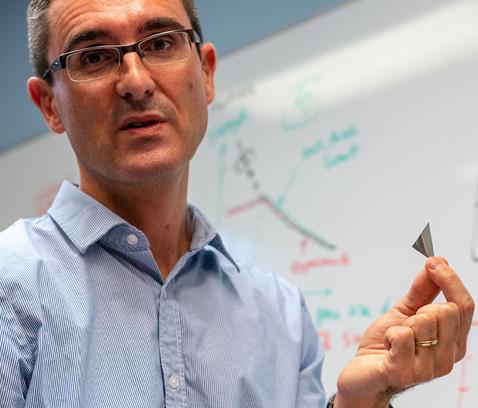
says. And he anticipates that the basic science revealed in the new study can lead to advances in technologies—from more efficient solar cells to lighter airplanes to safer nuclear power plants. “When you can make material stronger, you can use less of it, and it lasts longer,” he says, “and being electrically conductive is crucial to many applications.”
The Araguaian river dolphin of Brazil is something of a mystery. It was thought to be quite solitary, with little social structure that would require communication. But UVM biologist Laura May Collado and an international team of colleagues have discovered that the dolphins can actually make hundreds of different sounds to communicate, a finding that could help uncover how communication evolved in marine mammals.
The findings of May Collado and her colleagues were published in the journal PeerJ.
The team used underwater cameras and microphones to record sounds and interactions between dolphins and took genetic samples. They identified 237 different types of sounds the dolphins make, but even with twenty hours of recordings the researchers don’t believe they captured the animals’ entire acoustic repertoire.
“It’s exciting; marine dolphins like the bottlenose use signature whistles for contact, and here we have a different sound used by river dolphins for the same purpose,” says May Collado. The river dolphins also made longer calls and whistles, but these were much rarer, and the reasons for them are not yet clear. But there is some indication that whistles serve the opposite purpose than in bottlenose dolphins, with the river species using them to maintain distance rather than for group cohesion.
May Collado says the work could help researchers gain clearer understanding of how communication evolved in marine mammals. Similar calls have been reported in pilot whales and killer whales, for example, and the similarities and differences between different species could help tease out which signals evolved first, and why. CRACKING THE CODE OF MARINE MAMMAL COMMUNICATION


GAYE VS. SHEERAN

Professor Alex Stewart’s unique blend of musical and academic expertise has put him in the thick of some of the most celebrated music copyright battles of the last twenty years. His current cases say it all: Led Zeppelin’s alleged rip-off of the band Spirit in the opening guitar riff of “Stairway to Heaven” and Ed Sheeran’s alleged theft of musical elements from Marvin Gaye’s “Let’s Get It On” in his hit “Thinking Out Loud.” In both cases, Stewart is the musicologist for the legal team representing the original artist, although he has worked for both defendants and plaintiffs over the years.
Most people on campus know Stewart as the founding director of the university’s Jazz Studies program, a talented tenor saxophonist, and an ethnomusicologist with a book and numerous journal articles to his credit. His journey from the bandstand to the witness stand only seems unlikely. Stewart’s skill as a music transcriber—honed through years of writing out jazz solos from recordings and in his ethnographic work—is perfectly matched to the needs of a music infringement case, where two pieces of un-notated pop music have to be written out, so they can be compared to help determine whether similarity crosses the line to theft.
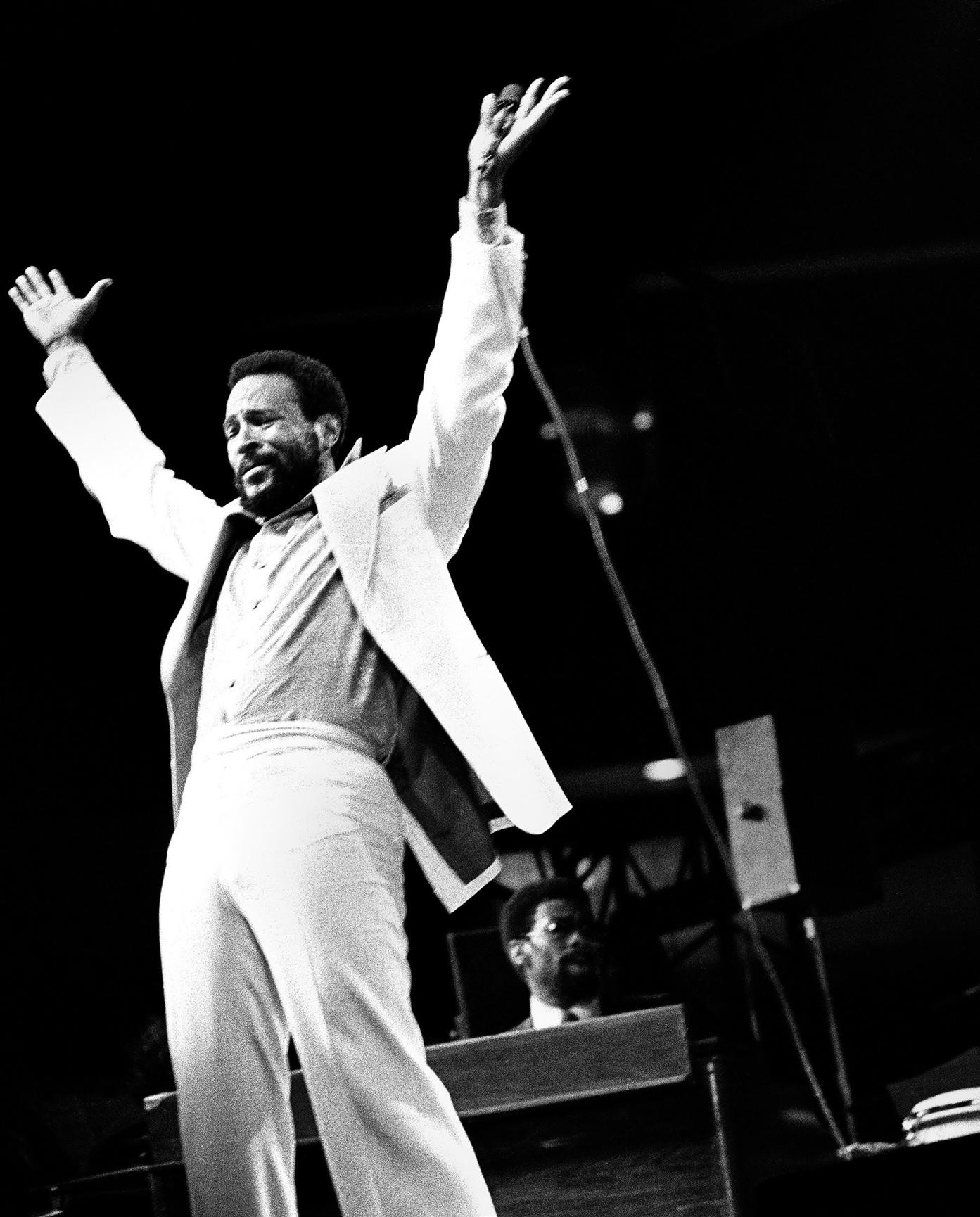
GARY STEIN, DIRECTOR OF THE UVM CANCER CENTER
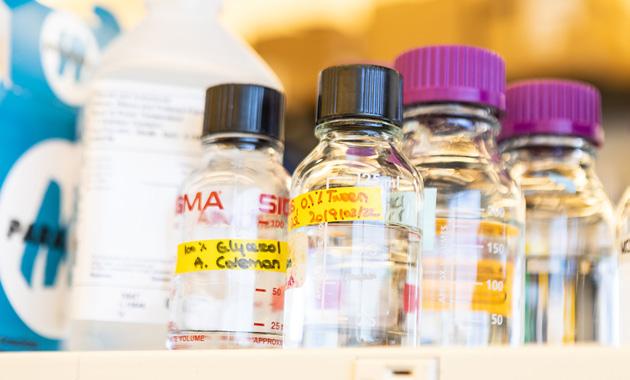
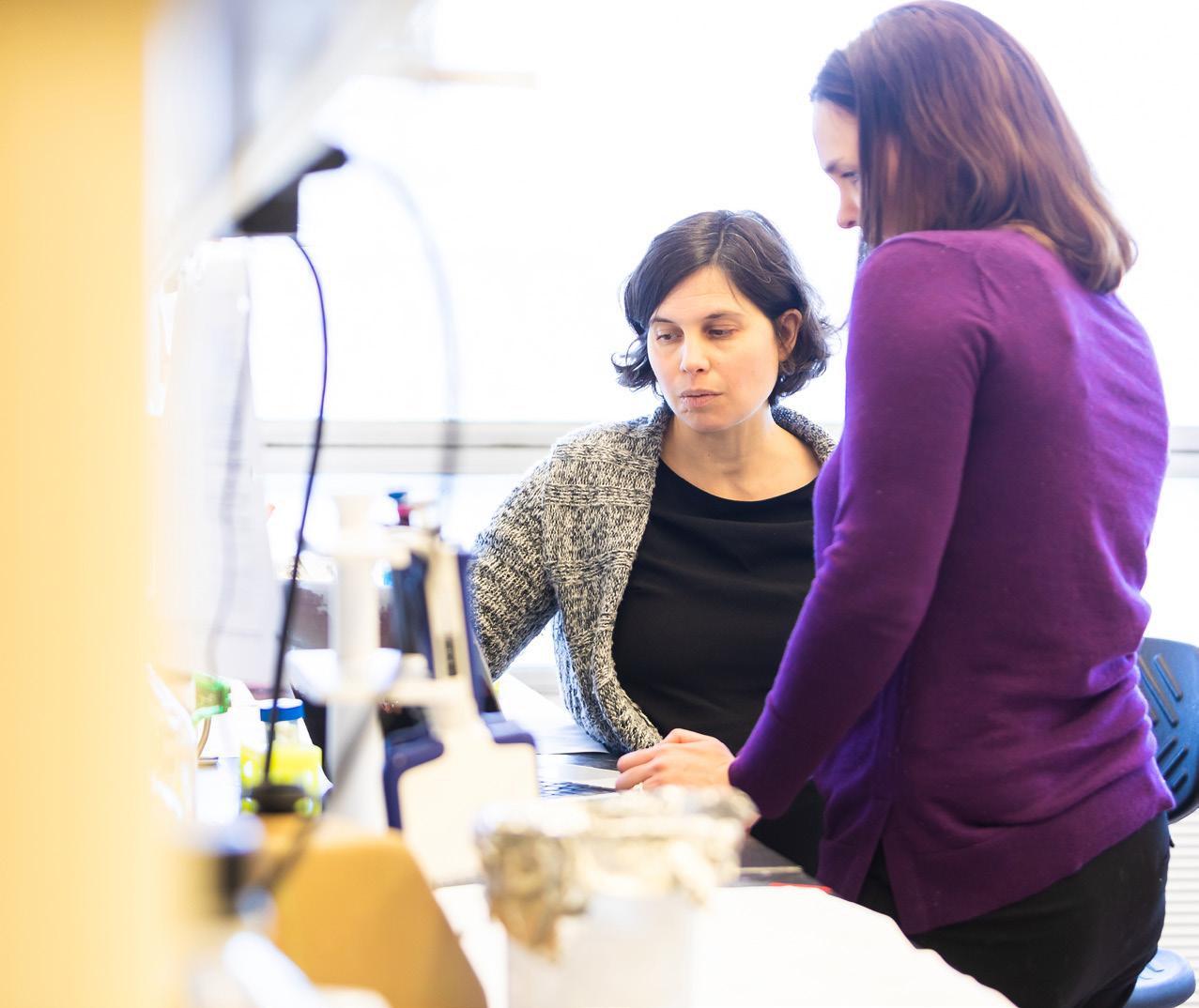
Delphine Quenet and Alissa Thomas







